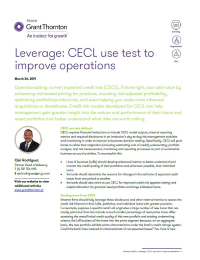Operationalizing current expected credit loss (CECL), if done right, can add value by enhancing risk-based pricing for products, boosting risk-adjusted profitability, optimizing portfolio/product mix, and even helping you make more informed acquisitions or divestitures. Credit risk models developed for CECL can help management gain greater insight into the nature and performance of their loans and asset portfolios and better understand what risks are worth taking.
CECL use test defined
CECL requires financial institutions to include CECL model outputs, internal reporting metrics and required disclosures in an institution’s day-to-day risk management activities and functioning in order to improve its business decision making. Specifically, CECL will push banks to refine their origination (including estimating cost of credit); underwriting; portfolio analysis; and risk measurement, monitoring and reporting processes as part of sustainable business-as-usual activities. To accomplish this:
• Lines of business (LoBs) should develop advanced metrics to better understand and monitor the credit quality of their portfolios and, whenever possible, their individual loans.
• the bank should determine the reasons for changes in the estimate of expected credit losses from one period to another.
• the bank should also strive to use CECL for improved credit risk appetite setting and capital allocation for granular level portfolios and large individual loans.
Getting more from CECL
Smarter firms should fully leverage these disclosures and other internal metrics to assess the credit risk inherent in their LoBs, portfolios, and individual loans with greater precision.
For example, suppose a specific retail LoB originates a large number of new loans that are mostly prime but that also include a much smaller percentage of near-prime loans. After assessing the overall initial credit quality of this new portfolio and existing underwriting criteria, the LoB buckets all the loans into the prime segment because, on an aggregate basis, the new portfolio exhibits prime characteristics under the bank’s credit ratings system. Could the bank have lowered its initial estimate of net expected losses? Yes. Here is how.
Go beyond checking the box to drive informed business decisions
The bank should have split the larger portfolio into two risk pools: prime and near-prime. The loans should have been priced in accordance with individual customer’s respective risk profiles, with higher prices for the near-prime customers.
The bank could mitigate future losses by capturing data at a granular level. It could spend more time to scrutinize the following information, which is embedded within the required CECL disclosures:
- reasons for impairments (pricing was not risk-based)
- the number of positions that are in an unrealized loss position (loan counts and proportion of loans in prime vs. non-prime segments)
- the severity and duration of the impairments (for each segment)
The bottom line? Don’t look at CECL as simply a compliance exercise. Leverage risk and performance insights to inform strategy, lending and pricing decisions to improve your results. Our integrated CECL approach can help address your full range of CECL concerns.


